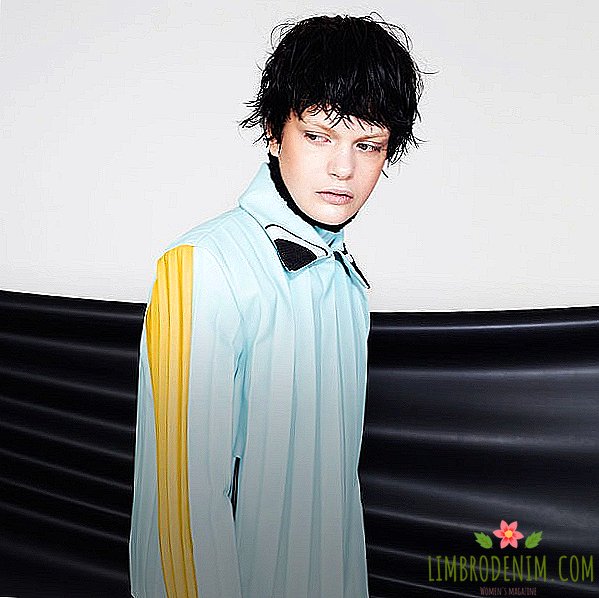Art critic Nadya Plungyan about favorite books
IN BACKGROUND "BOOK SHELF" we ask journalists, writers, scholars, curators, and anyone else not about their literary preferences and publications, which occupy an important place in their bookcase. Today our guest is Nadia Plungyan - art critic, curator and feminist.

I was taught to read early, at the age of three, and my real grandfather, Alexander Markovich Plungyan, instilled a real interest in the books. He always finds something unusual and exciting. Here is a vivid memory, I am four or five years old, and before bedtime he reads Oscar Wilde's "The Canterville Ghost" by horror and mystical shock. At about the same time I made a decision to reveal the secret of illustrators G. A. V. Traugot, who I really liked. For ten years puzzled what these letters mean. To learn, I had to become an art historian. At eight or nine years, I had a steady habit of reading on the go, in the subway and in the trains.
With my grandfather we are now exchanging books - recently, here we were discussing the book by Alexei Yurchak “It was forever, it was not over yet”, “The Tents of Fear” by Matvey Ruvin and Naum Wyman and the biography of Stalin Oleg Khlevnyuk. In general, any close and friendly relations for me have always been associated with the discussion of books. Those I have listened to the most for the last few years are Veta Morozova, Ira Roldugina, Maxim Burov and frau derrida. There are also some professional discussions about the history and art of the thirties, which I occasionally support with my colleagues: Alexandra Selivanova, Maria Silina, Kazimera Kordetskaya, Alexey Petukhov. Poetry is constantly discussed with Olga Akhmetyeva. An interesting library exchange was with director Alexei Levinsky and art historian Grigory Sternin. Books on contemporary art are periodically exchanged with artists - Zhenya Yakhina, Vika Lomasko.

For fun, I read fan fiction and anything about Soviet dissidence or populists

Of the underrated authors, I would like to name the poets: Anna Barkova, Nonna Slepakova, Boris Poplavsky, Gennady Gore, Sofia Parnok, Konstantin Vaginov, Natalia Medvedev. Over time, I stopped reading artistic prose - I get very tired of it, the sources are much more interesting. A recent exception is the story "Cactus" by the beautiful writer Lilit Mazikina. For fun, I read fan fiction and something about Soviet dissidence or populists. From a permanent background - any work on the history of everyday life of the XX century.
The most interesting literary language for me is the syllable of the diary, which turns into great literature. This is what I feel in some blockade records, and most of all in the diary of Pavel Filonov, I return to this book quite often. I reread the "Notes of the Independent" by Antonina Sofronova.
For a long time it was difficult for me to get rid of the Soviet attitude to books as an overvalued and expensive thing and to begin to perceive them as a tool. But when I had my own library, I began to make pencil comments in the margins. This greatly accelerated the work and helped to establish a dialogue with yourself, you better understand what is changing and what is changing.
Of the foreign books dominated by English and French. Sometimes you have to disassemble other languages, machine translation and intuition save the situation. Last time I try to switch to e-books, which are becoming more accessible, but the number of paper does not decrease. My main source of book extraction is, of course, second-hand booksellers all over the world, among which the first place is shared by the “Old Book” on Liteiny, alib.ru and American Amazon.

"Peppy Longstocking"
Astrid Lindgren
"Peppy" I read in five years thanks to my grandfather, who collected a high-class library of Soviet children's books. Everything is important here: both the 1968 edition, and the excellent (albeit free) translation of Lilianna Lungin, and the incredibly diverse and funny drawings of Lev Tokmakov, printed on bad paper in just two colors — black and red. Sometimes Tokmakov swings at the whole turn, sometimes scary shreds - and all this with a remarkable fabrication of lines and spots. "Peppy" Lindgren, Lungin and Tokmakova became for me something of a liberty textbook from the sixties, a role model that still delights many children when you read it out loud. Peppy is calm, fair and direct, and she also has a horse. She is not afraid of exams, gangsters, or shipwreck. This is a book about how to act and at the same time appreciate your own loneliness. This is a book about the need to build a distance from society, and then you will have the strength to change it.
Related books: Rudyard Kipling "Rikki-Tiki-Tavi" (translated by K. Chukovsky and S. Marshak, ill. V. Kurdova, 1935); Mikhail Tsekhanovsky "Mail", 1937; filing of the magazine "Tram" for 1991-1992.

"Tales of the Titans"
Jacob Golosovker. Drawings by Y. Kiselyov
Another adaptation, but this time from Stalin's time, I read its class in the second, also received from my grandfather. While this edition is thawing and has a child-friendly look, Kiselev’s illustrations clearly go back to the meager and solemn engravings of Favorsky, and the epic syllable retains the heavy trace of the “Soviet antiquity” of the thirties. If the philosophical works of Yakov Golosovkek saw the light in the USSR only in the late 1980s, then The Tales of the Titans became his first author’s book, published after the camp and the exile, and were compiled from drafts of the second part of a large theoretical work “Ancient Mythology as a Unified Myth about gods and heroes. " Apparently, this is not quite a children's book, but it made a deep impression on me with the hopelessly black finale of most of the plots. Now I think this is a book about repression under an ancient mask, under the mask of children's literature. Probably, it also has a manifesto of Soviet neoclassical heroism, and its collapse, its ambitions and weakness.
Related books:Mikhail Gasparov "Entertaining Greece"; Janusz Korczak "King Matyush I"; Ian Larry "The Extraordinary Adventures of Karik and Vali".

"1934 Diary"
Mikhail Kuzmin
I read this book, in my opinion, in the first or second year — from a general interest in Kuzmin. Before her, there was a biography of Kuzmin Malmstad and Bogomolov (1994), the cumbersome volumes of his poems from the 1990s and various anthologies. The text of the last of the famous diaries of the poet stuck in his memory once and for all, but it takes only one third of the book. The rest is a detailed scientific commentary by Gleb Moreva, which makes it a real encyclopedia of the literary and artistic environment of pre-war Leningrad: some footnotes take more than one page. At first, I simply wrote out sources and literature from “D-34” out of interest, then I set myself to read and study them all, then I went to the archive, and as a result my amateur hobby took shape in the constant interest in the themes of social exclusion in Soviet art 30-50 x years
Related books: Diana Lewis-Burgin "Sofia Parnok. Life and Work of Russian Safo"; Alexander Kobrinsky "Daniel Harms"; Dan Healy "Homosexual attraction in revolutionary Russia. Regulation of sex-gender dissidence".

"I see live"
Vsevolod Nekrasov
Recently, Vsevolod Nekrasov began to publish a lot, and during his lifetime he was regularly refused publications. Books were almost not available, except from friends or from him. "I See I Live" is his first hardcover edition and compiled by him in an interesting rhythm: poetry is combined with articles and reproductions of paintings from his collection. I return to Nekrasov often. It is not only a matter of beautiful poetry and caustic, brilliant revelations of postmodernism. His books remind me that if you simultaneously work in two spaces, combining analysis and artistic action, you can feel the nerve of time and become aware of its internal logic.
Related books: Oleg Vasiliev "Windows of memory"; Leon Bogdanov "Notes on tea drinking and earthquakes"; Polina Barskova "Living Pictures".

"Dmitry Isidorovich Mitrokhin"
Yury Rusakov
When I studied, this book had the most decisive influence on my professional choice and still seems to me a model of how to write about graphics, especially about print and book. It is necessary to simultaneously see how the thing is done technically, how innovation is introduced, what is the personal style - and understand its meaning in the context of the era, from the local to the art of other countries. But the main thing is to preserve both the sympathy for the material and the correct distance from it. In search of such a balance, I once read many wonderful books of the Leningrad department of the publishing house “Art”, but this one will always come first.
Related books: Alla Rusakova "Pavel Kuznetsov"; Elena Kochik "The Painting System of V.E. Borisov-Musatov"; Platon Beletsky "George I. Narbut".

"Totalitarian Art"
Igor Golomshtok
This book is important to me as the first systematic attempt to de-Stalinize Soviet art studies on a scientific basis. The main thing in it is the reinterpretation of the term "socialist realism" and a comparative analysis of the development of totalitarian art in the USSR, Germany, Italy, France and China. Alexander Morozov undertook another attempt to deconstruct the term, but his book The End of Utopia (1995) was no longer reprinted. But in stores, publications of Boris Groys multiply, which is considered to be the chief specialist in the thirties and comes from such logic that power is an art form. Unfortunately, in Russia, the authority of Groys is indisputable, especially among artists, and this freezes any conversation about social problems in art.
Related books: Yuri Gerchuk "Hemorrhage in the Moscow Union of Artists"; Jan Plamper "The Alchemy of Power. The Cult of Stalin in the Visual Arts"; Maria Silina "History and ideology. Monumental and decorative relief of the 1920s – 1930s in the USSR"; Efim Vodonos "Essays on the artistic life of the Saratov era of the" cultural explosion "1918-1932".

"Destroy all savages"
Sven Lindquist
Lindquist's very small book with a title taken from Joseph Conrad's "Heart of Darkness" tells about the history of Africa’s colonization in the 19th century and the birth of racism and genocide. It says a lot about changing attitudes towards domestic and social violence during the 20th century, about ousting and rationalizing; The author acts as a scientist and writer, combining facts from the history of his family with historical research. A few years ago, this book became an important part of the discussions about colonialism and racism, which we then constantly led in the feminist circle. It prompted many to reconsider their attitude not only to historical stereotypes, but also to various cultural phenomena, starting with Soviet adventure literature. I think that the main theme of the book is the history of dehumanization, which in Russia is still very little talked about.
Similar books: Shulamith Firestone "The dialectic of sex"; Arnhild Lauveng "Tomorrow I have always been a lion"; Michel Foucault "To Supervise and Punish. The Birth of Prison"; Elena Makarova, Sergey Makarov "Fortress over the abyss. Art, music and theater in Terezin, 1941-1945".

"Passing characters. Prose of the war years. Notes of the besieged man"
Lydia Ginsburg
Lydia Ginzburg became my favorite writer in high school when I read The Blockade Man's Notes. This edition is now the most complete. Few could so calmly and consistently show, being inside a situation, how social changes affect the inner life, how the human psyche is deformed under the influence of hunger, ideology, fear; what is a soviet person within the borders of his social system and beyond. In the Ginzburg books, the most important is the process of distancing from one's own epoch, the search for objectivity in oneself and ruthless self-analysis, without which, I think, any creative and scientific work has no meaning.
Related books: Anna Barkova "Forever not the same"; Nadezhda Mandelstam "The Second Book"; Euphrosinia Kersnovskaya "Rock painting".

"Hidden Tradition. Essay"
Hannah Arendt
Arendt's books on totalitarianism are well known, it was possible to advise them too. But since this is my personal list, I chose this book of small essays about the place of assimilated Jews in the culture of modernism and about the stages of assimilation of the minority with the majority. Here Arendt introduces the concept of pariah, discusses the “new” and “old” Jewry, how the opposition to his own stigma and internal xenophobia are formed. This problem concerns any minority. For me, these works by Arendt are always associated with the search for Simone de Beauvoir, who in the late 1940s summed up her thoughts on the place of women in culture and society.
Related books: Theodore Adorno "The Study of an Authoritarian Person"; Simone de Beauvoir "Second floor"; Herbert Marcuse "One-dimensional man."

"Ideology and Philology. Leningrad, 1940s"
Peter Druzhinin
The two-volume book of Druzhinin is an exhaustive study of the relations of the Leningrad philological community and power, built on archival material. I believe that Druzhinin found a middle ground in combining a source approach with social analysis, and it is extremely interesting that he relied on Olga Freidenberg’s still unpublished and “inconvenient” memories. This fact caused a heated discussion, painful for all its participants; after the publication of the book, it lasted more than one month, moving from social networks to magazines and back. The farther from our forties, the higher the need to re-see and reconfigure their everyday and political portrait, name all the defaults and understand their consequences. I hope that such studies will be more and more, and especially they are lacking in the history of Soviet painting.
Related books: Elena Vlasova "1948 in Soviet music. Documented research"; Mikhail Zolotonosov "Gadushnik. Leningrad Writing Organization. Selected Transcripts with Commentary (From the History of Soviet Literary Life of the 1940-1960s)"; Olga Reutenberg "Really someone remembered that we were ...".






